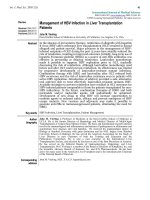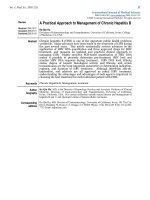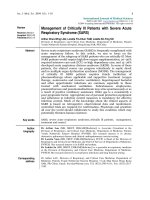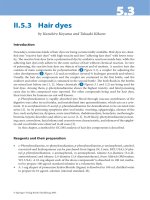45 contest prep fatigue management
Bạn đang xem bản rút gọn của tài liệu. Xem và tải ngay bản đầy đủ của tài liệu tại đây (539.95 KB, 16 trang )
UNIVERSITY
Contest Prep
Fatigue Management
Lesson Overview
•
•
•
•
•
•
•
How to make the process enjoyment vs suffering
What is REDs syndrome
Making Nutrition effective
Making cardio effective
Making training effective
Making lifestyle effective
Managing REDs side effects
Enjoy the Process and Outcomes
• The focus on an outcome over the process is much less rewarding as
you miss the value in self development
• Outcome focus also makes processes much less enjoyable and more
of a checklist
• Love what you do
• However, points of prep will be hard, and a level of suffering will
happen
• You will reach a point when easy fat loss stops, and we must dig hard
to keep getting to show level leanness
• No secrets to getting stage lean it does come down to calories and
calories out, which means low food and high cardio is realistic
• We must embrace being uncomfortable, no one changes being
comfortable
• When we get to these points of slowed fat loss and high fatigue, we
have strategies in place to make variables just as effective but keep
perception of “suffering” lower.
• This suffering can be rooted around Relative Energy Deficiency-in
Sport (RED-S)
Relative Energy Deficiency in Sport (RED-S)
IOC statement of common adaptation to low energy availability
(low body fat and low energy intake and/or high energy
expenditure) Mountjoy 2018.
Barriers are Present Within Suffering
• Extreme dieting can cause a great drive for binge eating
• Bodybuilders typically display more binge eating patterns than noncompeting counter parts.
• Daily tracking of calories and body weight can exacerbate disordered
eating and decrease mood
• These mental and physical challenges present barriers to being
”successful on stage”
• Lack of adherence can root from dieting too “hard” or too long
• Lack of preparation of not dieting long enough or hard enough
• Mentally this process can decrease confidence in small failures of the
process which breaks people to quit
• Rigid non-flexible approaches can drive a lot of the difficulty in a
successful prep.
• This process will be hard, but we want to set up an athlete to be
successful as possible and make the process as effective but “easier"
when needed.
Managing Training Fatigue
Contest prep is an inevitable rise in fatigue and decreased recovery ability
Autoregulate load/reps/volume just like in any other phase
This is no excuse to wuss out when times get tough
You will be fighting to uphold load and reps at some point on prep
Start of prep
training creates less protein synthesis response
Recovery is higher, less protein break down
End of prep
Training is harder to carry out to achieve the same stimulus
Recovery is diminished and protein degradation is higher
Throughout prep we must account for less recovery and need to uphold
stimulus
Managing Training Fatigue
Strategy 1:
Low set volume per session as needed to maintain performance
Remove cardio heavy metabolic work (super sets, high reps)
Remove set extenders (rest pause, failure forced reps)
Strategy 2:
Split training session volume into more frequent sessions to shorten the
session
Push Pull Off Legs OFF into Push Pull delt/arm legs off
Or
Push Pull legs Off into upper lower off
Strategy 3:
Switch exercises to fewer fatiguing movements that require less
stabilization
Start of Prep: Deadlift Mid Prep: Machine Good morning End Prep: back
extension
Strategy 4:
Deload week can be utilized mid prep to take the foot off the gas and
recharge
Cardio Fatigue Management
Between HIIT vs Moderate Intensity Steady State vs Low Intensity
Steady State there is no superior option from a fat loss aspect. Viana
2019
However, time efficiency is much greater with higher intensity, but
these higher intensity can generate more fatigue
The higher intensity cardio done concurrently with resistance training
can impeded lower body hypertrophy and strength gains. Sabag 2018
Why even do cardio as a competitor? This is purely to create an energy
deficit and offset metabolic changes and decreases in NEAT as you
become leaner
Large decreases in NEAT during dieting are usually reason for fat loss
stalls. (Prep gets harder, you move around less)
Cardio Fatigue Management
Primary Strategy
• Low Intensity Steady State (LISS) Cardio and Steps
• Lowest impact is stay active and increase step count (LEAST
FATIGUEING AND negligible impact on hypertrophy)
• Also enjoy podcast, music, outdoors, spouse or friend
• Later stage of prep focus on step count increases when recovery is
low and muscle break down is high.
Secondary Strategy
• Moderate Intensity Steady State (MISS) Cardio
• Select the cardio modality that mimics resistance training range of
motion like cycling or the ARC trainer, incline treadmill has
application.
• Limit high impact/eccentric cardio (jogging, stepmill, etc)
• Keep moderate intensity cardio sessions to 20-30 minutes in
duration. Increase frequency as needed
• If done on the same day as weight training, do moderate intensity
cardio 6 hours before or after weights.
• Moderate and HIIT cardio session number should NOT exceed the
number of weight training sessions per week.
Cardio Fatigue Management
Tertiary Strategy
• High Intensity Interval Training (HIIT)
• Select the cardio modality that mimics resistance training range of
motion like cycling or the ARC trainer.
• Allow 48-72 hours before lower body resistance training.
• Moderate and HIIT cardio session number should NOT exceed the
number of weight training sessions per week.
• Female Consideration: Higher recovery capacity than males; lighter
body weight needing longer durations or higher intensities
• Fasted vs Fed Cardio:
Fasted cardio offers limited to no advantage over fed state cardio.
• Fasted cardio can be perceived harder in a morning state
(wakefulness, hydration status)
• If fasted, limit yourself to low and moderate intensity cardio. A
serving of protein prior may have metabolic advantages for fat loss
and limit muscle protein breakdown if you need long duration times.
Schoenfeld 2014
• Prioritized sleep over waking earlier for cardio (sleep=fat loss)
• Caveat is PED/Supp enhanced fasted cardio via HGH, Clen, yohimbine
HCl, Carnitine
Nutrition Fatigue Management
There is a psychological and physiological component to nutrition in prep
One aspect is how you feel, the other is how you perceive the situation around those feelings
The psychology of a person can dictate the approach that may increase psychological stress and
make dieting feel “harder”
Regimented Dieter
• Less experienced competitor
• Anxiety around options
• Highly neurotic
• Needs to trust the process
• Caters well to structured meals and tight food tracking
• Less educated on food tracking
• Poor reliability in biofeedback
Flexible Dieter
• Experienced competitor
• Self developed for biofeedback
• Low emotional response to changes positive or negative
• Educated on food tracking and high autonomy
• Can trust biofeedback (hunger, energy levels, full vs flat)
• Understands stage leanness
Nutrition Fatigue management
Regimented Dieter
Best with food-based plan
Educate to build confidence for great flexibility
Start with food based macro-options
Flexibly Dieter
Macro Numbers provide only
Ability to select food sources
Variety keeps prep fun and interesting
Ability to shift macros to times of peak hunger
Other Strategies
Diet breaks around times of high life stress on prep or travel
Refeeds on high physical and mentally demanding days
Cheat meals on weekends or when able to be social
Cyclic Dieting Approaches
Common Prep Issues
Food Focus
Stay busy with work
Avoid food shopping online
Constipation
Low fiber, low volume diet, decrease GI motility
Keep fiber intake at 14g per 1000kcal
Keep water intake 1oz per lb of body weight
Decreased mental focus, mood, lethargy
Structure busy times around best mental state
Shift meals around those time to support productivity
Relaxation and naps when needed
Track steps to keep energy output up
Common Prep Issues
Poor Sleep
Review Sleep Lecture
Taper fluids down towards bedtime
Keep last meal with veggies and high food volume for hunger
Loss of Menstrual Cycle
Not much can be done
Potential diet breaks and cycle calorie approach delayed loss
Increased Hunger
Stick to meal timing and structure
Increase high volume foods like salads
Hot and cold beverages
High protein intake
Increase water consumption
Common Prep Issues
Increase in Cold
Decreased body fat root issue
Dress in layers
Hot fluids
Libido Loss
PEDs or HRT therapy
Stay communicative to partner
Continue date nights
Increased Insecurities
Body image is more scrutinized
Focus on feedback from coach and support network
Limit time comparing to others and social media
Lightheaded/Dizzy
Monitor blood glucose
Shift food around times of low blood glucose
Blood pressure decreases, stand up slow, increase hydration and sodium
References
Mountjoy M, Sundgot-Borgen JK, Burke LM, Ackerman KE, Blauwet C,
Constantini N, Lebrun C, Lundy B, Melin AK, Meyer NL, Sherman RT,
Tenforde AS, Klungland Torstveit M, Budgett R. IOC consensus statement
on relative energy deficiency in sport (RED-S): 2018 update. Br J Sports
Med. 2018 Jun;52(11):687-697. doi: 10.1136/bjsports-2018-099193.
PMID: 29773536.
Sabag A, Najafi A, Michael S, Esgin T, Halaki M, Hackett D. The
compatibility of concurrent high intensity interval training and resistance
training for muscular strength and hypertrophy: a systematic review and
meta-analysis. J Sports Sci. 2018 Nov;36(21):2472-2483. doi:
10.1080/02640414.2018.1464636. Epub 2018 Apr 16. PMID: 29658408.
Viana RB, Naves JPA, Coswig VS, de Lira CAB, Steele J, Fisher JP, Gentil P. Is
interval training the magic bullet for fat loss? A systematic review and
meta-analysis comparing moderate-intensity continuous training with
high-intensity interval training (HIIT). Br J Sports Med. 2019
May;53(10):655-664. doi: 10.1136/bjsports-2018-099928. Epub 2019 Feb
14. PMID: 30765340.
Schoenfeld, B.J., Aragon, A.A., Wilborn, C.D. et al. Body composition
changes associated with fasted versus non-fasted aerobic exercise. J Int
Soc Sports Nutr11, 54 (2014). />









